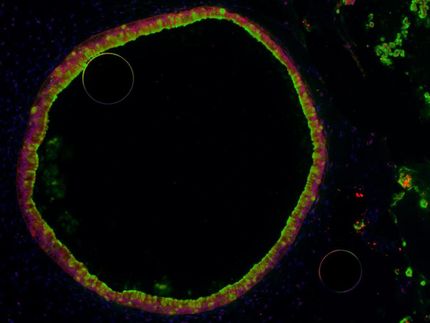Fish Eyes from a Petri Dish
Scientists create retina from stem cells of bony fish
A research team from the Centre for Organismal Studies (COS) of Heidelberg University has demonstrated that complex retinal tissue can be cultured in a Petri dish from embryonic stem cells of bony fish. Until now, stem cells from mammals, including humans, have been used in organoid research. For the first time, researchers led by Prof. Dr Joachim Wittbrodt have demonstrated that stem cells from medaka and zebrafish can also form highly organised neural structures under controlled laboratory conditions. Among other things, the researchers expect to gain new insights into the basic mechanisms of retinal development.

Side by side comparison of the emerging retina in the fish embryo and in the retinal organoid grown in a Petri dish.
Adaptiert aus Zilova, Weinhardt, et al., eLife 2021, 10:e66998, CC BY 4.0
Organoids are bits of tissue that are grown from stem cells and resemble actual organs. They are used in basic research to gain new information on cell organisation and organ development, to investigate the origin of disease, and to develop and test new medications. “The major advantage of fish organoids is that they are highly reproducible, unlike organoids from mammalian stem cells. They develop reliably and very quickly and enable a direct comparison with living embryos that in fish grow outside of the womb,” explains Prof. Wittbrodt, who heads the Animal Physiology and Developmental Biology research group at the COS. “We are therefore able to manipulate the molecular and genetic mechanisms of retina formation, much like engineers.”
Previous studies using stem cells from zebrafish had already suggested that they go through specific stages of embryonic development when appropriately cultivated. Until now, however, none of the Heidelberg researchers knew of an experiment in which cell cultures from fish successfully organised into highly complex neural structures like the retina. “Our study has closed this gap in organoid research,” underscores Dr Lucie Zilova, a postdoctoral researcher in Joachim Wittbrodt’s group. “We succeeded in cultivating the stem cells from bony fish such that they underwent an astonishing developmental process in a little less than a week. In the end, we had a complex retinal structure.”
To this end, the Heidelberg team used pluripotent stem cells from medaka and zebrafish embryos. Such cells have not yet differentiated and can potentially develop into many different cell types. According to Dr Zilova, all the cells taken from a single embryo independently aggregated into one large retina within 24 hours. In a matter of a few days, it then formed layers of different cell types that are also found in the fish eye, including photoreceptor cells, bipolar cells, amacrine cells, and ganglion cells. “The growth process proved to be incredibly efficient,” states the researcher. Hundreds of small retina organoids could be generated within a day. The high throughput allowed the researchers to precisely isolate the conditions in which structures resembling a head with two eyes, including both brain and retina, are formed.
“However just because an organoid structure looks like a retina doesn’t mean that the cells behave and grow as they would in a living embryo,” adds Dr Venera Weinhardt, another COS postdoc. To explore this question, the researchers used light sheet fluorescence microscopy, an imaging process that supports real-time observations, to compare the behaviour of cells in the culture with that of cells in the embryo. “The analysis clearly showed that there were no differences. In both the culture and the embryo, the cells moved along specific routes to the outer periphery of the eye bud and combined into the so-called optic vesicle,” continues Dr Weinhardt.
The Heidelberg researchers also noted that the organoids from the evolutionarily different medaka and zebrafish are quite similar. That leads them to believe that the molecular and genetic mechanisms of early eye development have been retained throughout evolution across different species and independently of environmental influences to which the embryonic cells are exposed during their development. Whether embryonic stem cells in a culture can form other organoid structures besides the retina remains an open question.



















































